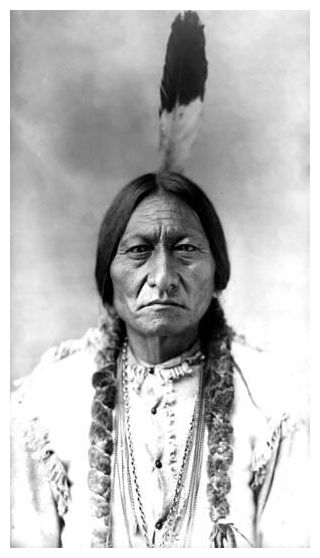
© sonofthesouth.netChief Sitting Bull
By comparing DNA samples from hundreds of volunteers, a Penn anthropologist and his colleagues have tied Native Americans to a group of people living in a small region of Russia called the Altai, near the borders of Mongolia, China, and Kazakstan.
The results, published in Friday's issue of the
American Journal of Human Genetics, add another chapter to the story of the settlement of the Americas. Increasingly efficient DNA technology is helping scientists flesh out the prehistory of the Native Americans and of the human race in general.
Archaeologists have long surmised that Native Americans came from Asia, migrating to Alaska during a time when sea levels were lower and it was possible to walk over the Bering Strait.
But these latest results use the most complete genetic profiling done on the Asian and American sides, offering new insights into the ancestry of Native Americans, the routes they took to the New World, and the timing of the migration.
Artifacts show that humans were living in North America 15,000 years ago; they reached the tip of South America over the next 2,000 years.
Using techniques akin to DNA fingerprinting, scientists have continued to gather evidence that the majority of current native people of North and South America derive their ancestry from Asia.
University of Pennsylvania researcher Theodore Schurr's group focused on two types of DNA - mitochondrial DNA, which is passed down in eggs and traces maternal lines, and the Y chromosome, which is passed down through male lines.
The Y chromosome analysis took advantage of non-coding regions, which are not part of genes and which are used in criminal forensics to match suspects to crime scenes.
These DNA regions differ from one person to another, Schurr said. The more such quirks people share, the more recently they are likely to have had a common ancestry.
Schurr said his group had collected about 1,500 DNA samples from Native Americans, as well as 750 from people in the Altai. The researchers also compared DNA from people from other parts of Asia.
The scientists can use groups of variations on the Y chromosome to identify specific human male lineages, and variations in mitochondrial DNA to trace female lineages. Male lineages called Q, and a subset of Q called Q-M3, appear widespread in Native Americans and are thought to have come from a founder population. Both also appear in people from the Altai region, Schurr said.
Common sequences in mitochondrial DNA called A, B, C, and D also appear to have been ubiquitous in pre-conquest America, and Altains have them, too.
Though other Asians carry a few of those patterns, only the Altains and some subgroups of Mongolians had them all.
Interestingly, Schurr said, the Altai is also where scientists recently found a 41,000-year-old bone from a newly discovered member of the human family tree dubbed a Denisovan. DNA analysis of the bone showed that, like Neanderthals, Denisovans apparently co-existed with modern humans and interbred with some of them.
Schurr also used differences between Altain and Native American DNA to suggest the two populations diverged 25,000 to 20,000 years ago.
He believes his data fit with the Beringian incubation theory, which posits that people first moved to a region now under the Bering Strait.
When the ice age started to subside around 15,000 years ago, people from Beringia were able to spread out into North America, by land or boat or both. At some point, they had to leave before their homeland was submerged.
Anthropologist Connie Mulligan of the University of Florida said that until the 1990s, linguists thought people must have come over in waves of migrations, but genetics pointed to one major wave.
Mulligan, who is among the originators of the Beringian incubation theory, said she favored a different interpretation in which the Altains are not ancestral to Native Americans, but instead share a common ancestor with the Beringians, who may have occupied the then-dry Bering Strait 30,000 years ago.
In her scenario, when the ice age ended, some Beringians moved down into the Americas and some settled in the Altai. The genetic relationship between Altains and modern Native Americans would come from sharing a common ancestor with this long-gone group.
Many details remain hazy before the crossing of the land bridge, as well as after, when people made remarkable progress in settling both continents.
University of Arizona anthropology professor Stephen Zegura said analysis of other parts of the DNA promised to add much to the story. The contribution from genetics, he said, has just begun.
Is it possible that the gene flow went the OTHER WAY?